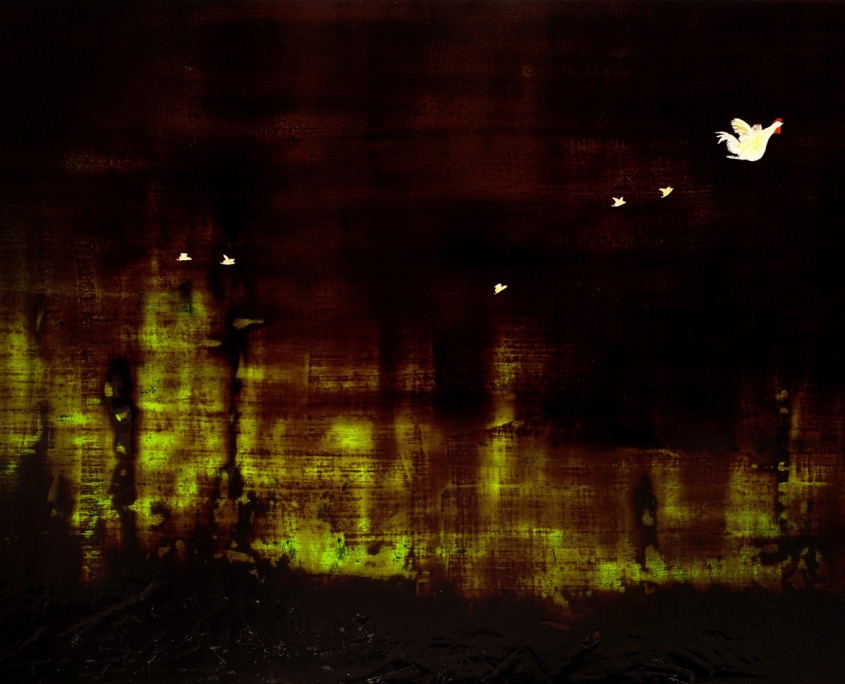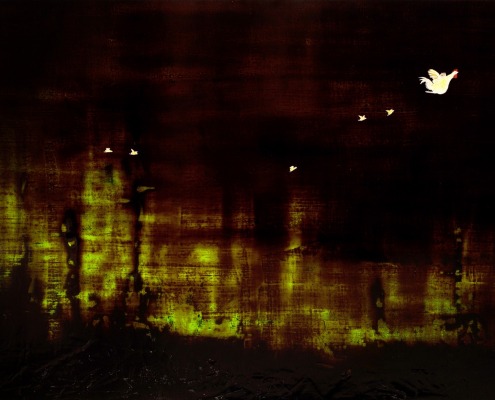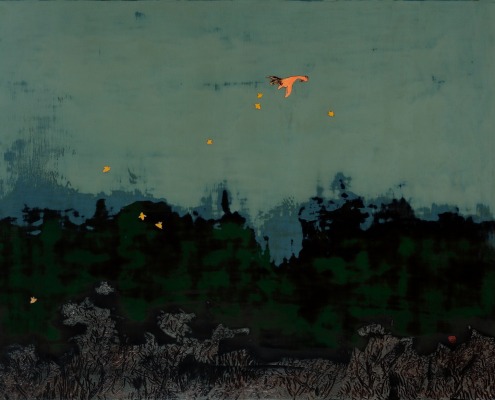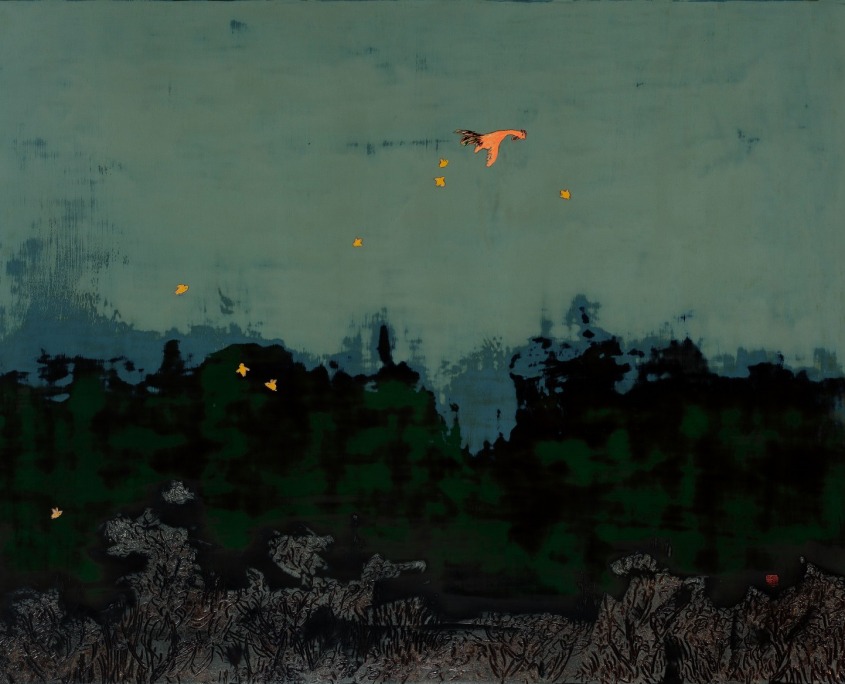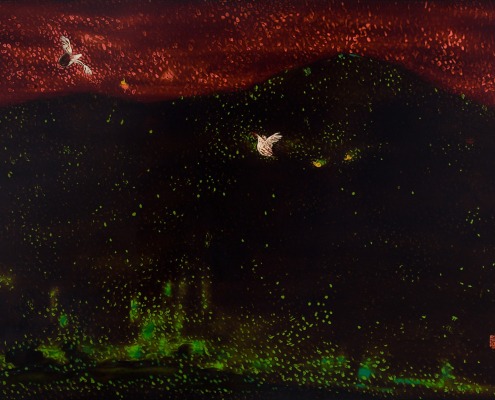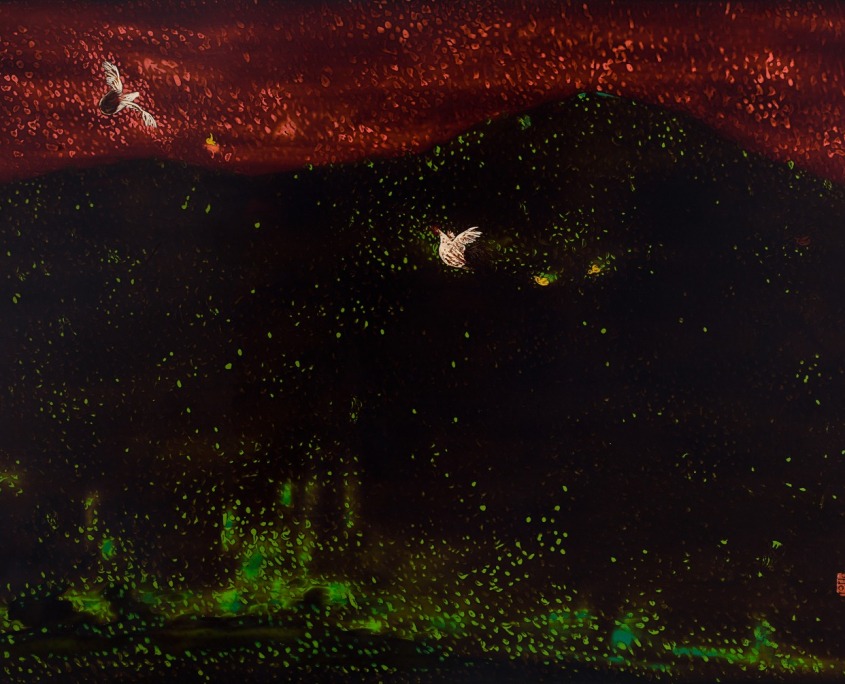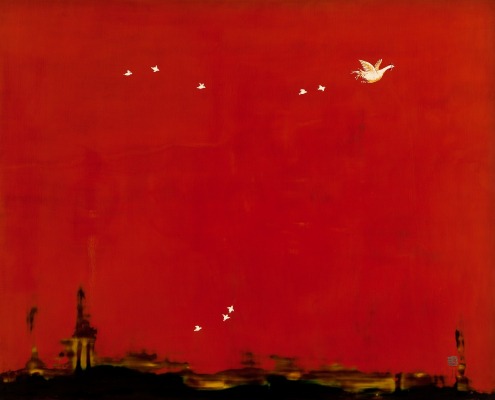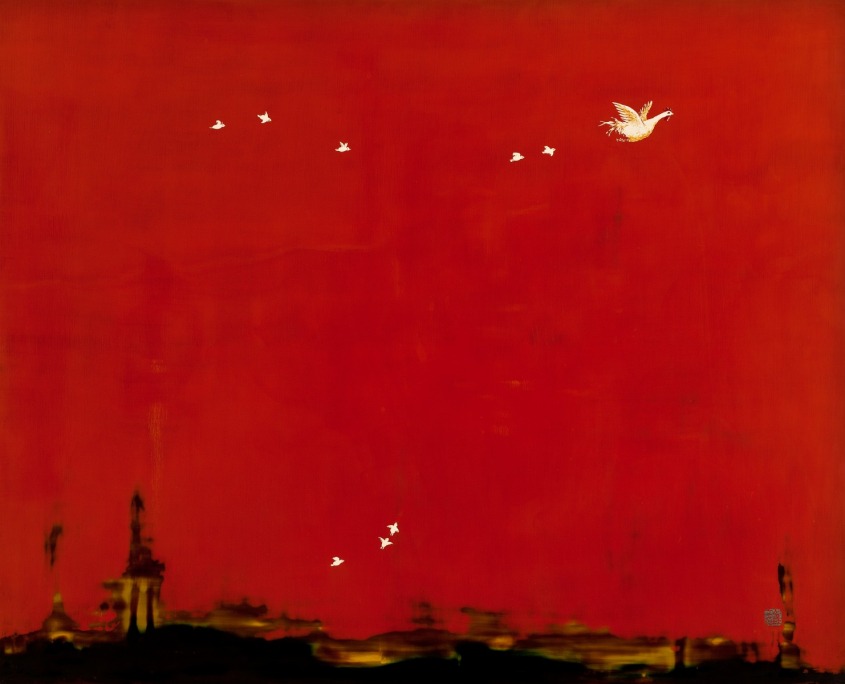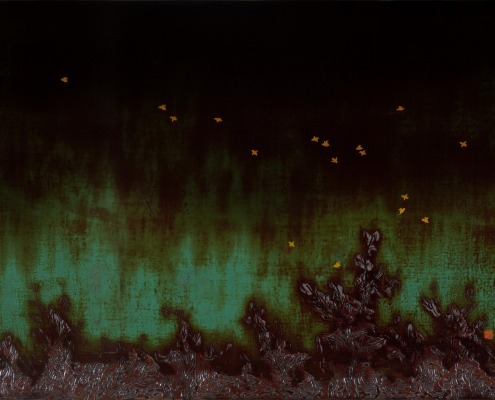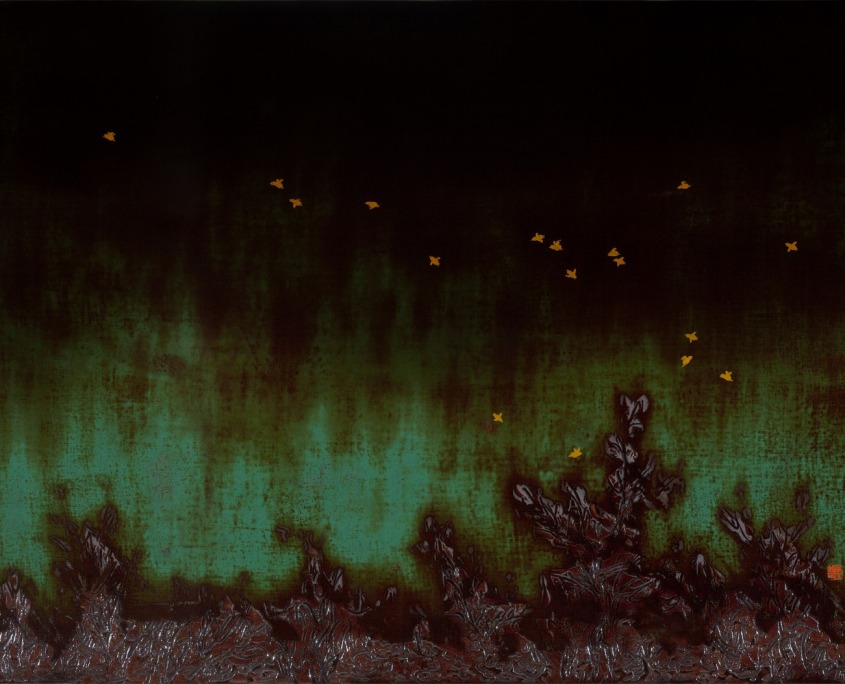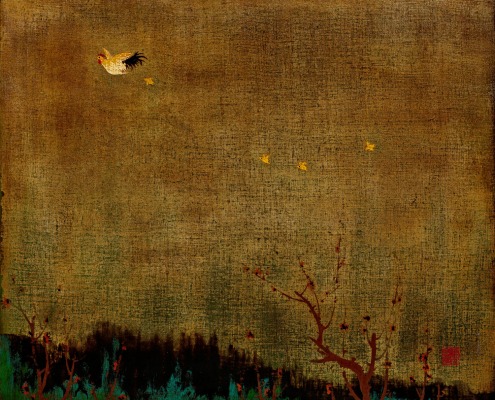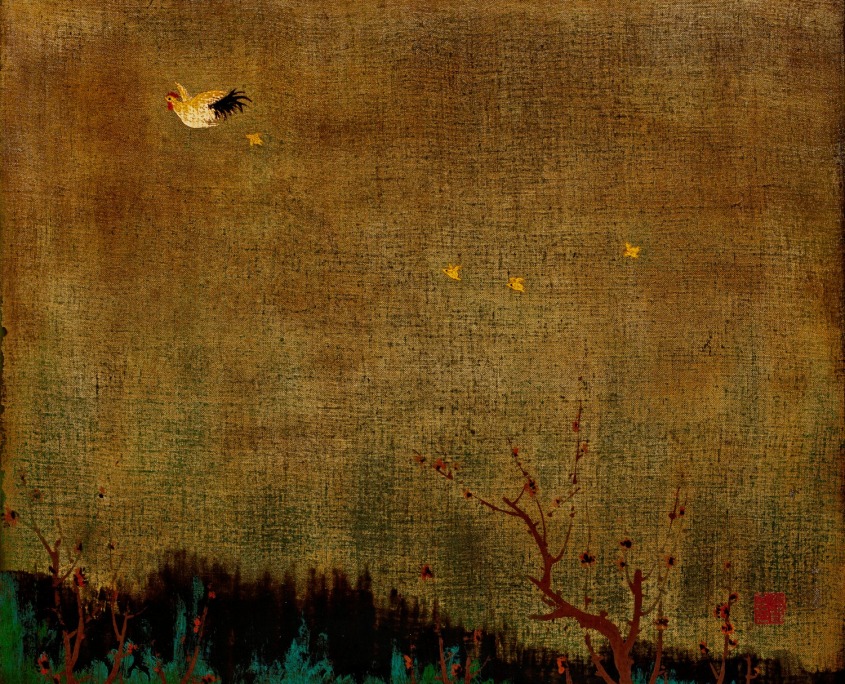Seong Taehun
성태훈
날아라 닭 展
2015.3.5-3.28
- 작품평론
“닭은 아득한 이상의 공간에서 봉황으로 난다”
김상철(동덕여대 교수, 미술비평)
닭이 하늘을 난다. 어린 병아리들을 거느리고 나들이 하듯이 하늘을 난다. 도시의 하늘을 부유하기도 하고, 향기 그윽한 매화나무 속을 날기도 한다. 작가 성태훈의 작업을 견인하는 것은 나는 닭이다. 그의 닭은 그렇게 날아오르며 작가로서의 그를 각인시켰다. 닭은 다양한 공간들을 날아 오늘에 이르렀다. 그것은 작가가 감내한 현실적인 삶과 작가로서의 이상, 그리고 자신이 속한 시공에 대한 진지한 사유의 기록이다. 사실 이러한 여정은 적잖은 질곡과 변화를 통해 이루어진 것이다. 그것은 전통회화로서의 한국화의 정체성과 시대정신, 그리고 그 속에서 이루어진 자신의 삶에 대한 성찰과 번민을 오롯이 담고 있는 것이기도 하다. 그는 이를 화두삼아 수행과도 같은 성실하고 묵묵한 여정을 통해 오늘에 이른 것이다. 그에게 있어서 작업은 개인의 사유를 각인하는 조형 언어인 동시에 그가 마주한 현실의 또 다른 반영이기도 하다.
그의 닭은 아픔과 고통 속에서 태어났다. 그의 작업은 실경에서 비롯된다. 우리 현대사에서 특별한 의미를 지니는 ‘광주’라는 시공과 남도 일원에 산재한 유배지의 순례를 통해 그는 자신의 가슴에 아린 상처를 품었다. 실경을 통해 역사의식을 명료하게 다잡고 이를 자신의 내밀한 삶의 역정과 연계하고자 하는 그의 작업은 애초부터 분명한 지향을 지닌 것이었다. 그에게 실경은 전통적인 한국화의 경직된 형식주의에서 탈피하기 위한 수단이었으며, 이를 통해 자신이 속한 시대를 기록하고자 하였다. 실경이 산수, 혹은 풍경이라는 제한적 의미와 경계를 벗어나지 못하고 있을 당시, 그의 의식은 매우 분명하고, 그 지향은 대단히 구체적인 것이었다. 이러한 현실에 대한 절박한 인식은 어쩌면 그의 작업에 있어 태생적인 것이었는지도 모른다. 그 시작이 그러하였고, 또 일련의 전개 과정을 거쳐 오늘에 펼쳐 보이는 결과를 가늠해 본다면 이는 어렵지 않게 확인되는 바일 것이다.
현실과 이상의 부조화와 모순은 그의 작업을 지탱해주는 화두라 할 것이다. 그는 이를 자신의 이상과 삶, 그리고 자신이 속한 시대를 통하여 부단히 고민하고 표출하였다. 그것은 극히 이성적인 것인 동시에 다분히 감성적인 것이기도 하였다. 시공을 넘나드는 공간의 구성과 수묵과 채색을 구분하지 않는 분방한 표현, 그리고 다양한 소재에 대한 다양한 선택과 융합 등은 그의 사유를 표출하기 위한 모색의 결과라 할 것이다. 그의 작업이 일정한 방향성을 구체적으로 드러낸 것은 아마 ‘9.11 테러’로 기록되는 충격적인 사건을 목도한 이후일 것이다. 이 사건을 계기로 작가는 현실과 이상을 가늠하며 그 괴리와 간극의 부조화와 모순을 기록하기 시작한다. 소박한 욕실 풍경과 거대한 문명의 폐허의 대비는 아마 그 극렬함만큼이나 큰 현실과 이상의 괴리를 드러내는 것이었다. 이어 그의 작업은 현상 자체의 대비나 충돌을 통한 메시지의 제시에서 보다 함축적이고 은유적인 것으로 변화하게 된다. 그것은 바로 사군자, 특히 매화를 비롯한 식물 등 모필 취미가 드러나는 관념적인 사물과 헬리콥터, 전투기 등 전혀 이질적인 사물들의 공존으로 나타나게 된다. 그것은 관념적인 사물들의 병열을 통해 또 다른 시각적 자극과 관념을 구축하는 것이다. 유교적 덕목을 상징하는 매화는 문인들의 정신적 이상의 상징이다. 작가는 이를 기계문명의 절정인 전쟁 무기들과 대비시켜 그 이상의 허망함과 모순의 현실을 지적하고자 한 것이라 이해된다. 그리고 그 공간 속에 닭을 날아오르게 하였다. 그것은 아름답고 우아한 비행이 아니라 치열한 실존의 확인인 동시에 생존을 위한 처연한 몸부림이다. 물질문명의 상징인 빌딩 숲을 날아오르고 유교적 가치의 지엄한 정신세계를 가로지르는 닭은 생존을 위한 뜀박질과 절규로 그 시공을 날아올랐다. 그것은 풍자라기에는 보다 심각하고, 해학이라 하기에는 무겁고 슬픈 것이었다.
작가의 근작들은 날아오르는 닭에게 새로운 공간을 제공하고 있다. 검은 수묵보다 훨씬 깊고 아득한 옻칠의 세계는 작가가 천착하는 새로운 공간이다. 그것은 어둠 속에서 길어 올린 사변의 색이다. 이는 단순히 재료의 변용이나 조형의 변화에 그치는 것이 아니라 그의 조형적 지향이 이전과는 사뭇 다른 곳을 지향하고 있다는 점에서 흥미롭다. 주지하듯이 옻은 인류문명과 연륜을 같이하는 대단히 오랜 재료이다. 특유의 물성에서 비롯되는 그윽한 깊이와 불변성 등의 특질은 근자에 들어 새삼 현대미술의 새로운 매재로 각광받고 있는 바이기도 하다. 작가는 이를 통해 현실과 이상이라는 이질적인 가치를 현상이 아닌 관념으로 수렴하고 있다. 그가 설정한 옻칠의 공간은 이상과 현실을 아우르는 절대공간인 셈이며, 그것은 감지되는 것이 아니라 인식되는 것이다. 반복적인 작업 과정을 통해 구축되는 침잠되는 공간의 깊이는 매우 깊고 아득하며 또 무작위적인 것이다. 이는 현상을 설명하는 것에서 벗어나 그 자체가 일정한 의미와 가치를 지닌 조형의 주체이다. 작가가 옻칠에 주목한 것은 바로 이러한 재료의 특성과 그 독특한 심미 때문일 것이다. 이는 재료와 표현의 변화라는 제한적인 의미를 넘어 그의 사유를 확대할 수 있는 효과적인 공간을 확보한 점이라는 면에서 긍정되는 바이다.
작가의 작품에서 닭은 자신의 반영인 동시에 현실을 살아가는 소시민적 존재의 처연한 자화상일 것이다. 그는 퇴화된 날개의 치열한 날개 짓을 통해 이상을 지향한다. 봉황은 그의 이상을 대변하는 상징일 것이다. 날지 못하는 새의 현실에서 삶의 곤궁함과 현실의 피폐함을 확인하고, 다시 그 날개 짓을 통해 봉황의 비상을 꿈꾸는 그의 이상은 어쩌면 멀고도 아득한 것인지도 모른다. 그는 옻칠이라는 새로운 형식의 아득한 침잠의 공간을 통해 짐짓 복잡다단한 현실에서 이상의 아득한 곳에서 자신의 비상을 꿈꾸는 것이라 여겨진다. 그의 작업에서 닭은 봉황으로 읽음이 당연할 것이다. 단지 그것이 아직 삶이라는 현실의 공간을 미처 벗어나지 못하고 있기 때문에, 또 장차 봉황으로서 비상할 닭의 내일을 가늠할 여유나 안목이 없는 현실에서 여전히 닭으로 읽히는 상황이 안타까울 따름이다. 자신의 삶과 자신이 마주하고 있는 주변에 대한 치열하고 따뜻한 그의 관심과 지향이 비상할 날을 기대해 본다.
“The Roosters flies in a dim ideal space as the phoenix”
(By Kim Sang-cheol, Professor of Dongduk Women’s University)
A Rooster flies. The Rooster flies in the sky, leading a brood of Roosters, as if on a picnic. They float through the urban sky or fly over plum trees, radiating the sweet scent of plum blossoms. The primary motif of artist Seong Tae-Hun’s work is the flying Rooster. The Rooster was conducive to engraving his existence as an artist into the world. The Rooster has flown through diverse spaces up to the present. The flying Rooster can be seen as a metaphor for a chronicle of his serious thought on the down-to-earth life he has endured, an ideal he has as an artist, and the space-time he belongs to. The journey has been realized through more than a few ordeals and changes. This shows Korean painting’s identity and spirit of the times as traditional painting, and his introspection and anguish regarding his life based on such identity and spirit. He has attained what he is through a sincere, consistent journey, like practicing asceticism. His work is a modeling language to manifest his thought and simultaneously a reflection of the reality he has faced.
His Roosters came into being through pain and agony. His work derives from real-view landscape. He felt such pain and agony through his journey to the space and time of “Gwangju”, very special in our contemporary history, and also places of exile scattered in the southern province of Korea. His work clarifying historical consciousness through real-view landscape, and associating this with the journey of his life, initially had an apparent pursuit. True-view landscape was a means to escape the stiff formalism of traditional Korean painting, and he intended to chronicle the age he belongs to through this means. In the days when real-view landscape had its import and arena trammeled by that of sansu or landscape, his consciousness was very obvious and his pursuit was very concrete. His desperate awareness of such reality is perhaps originally inherent in his work. Judging from the accomplishments he has attained, this can be verified with ease.
The main topic sustaining his work is incongruity and contradiction between reality and ideal. Seong has constantly represented this through his ideals, life, and the time he belongs to. His representation is extremely ideal and quite emotional at the same time. The composition of space crossing space and time, freewheeling expression making no distinction between ink and color, and a choice of diverse subject matter result from his exploration to manifest his thought. His work began concretely seeking a certain direction after he had witnessed a shocking event: the September 11 attack. This incident made him judge reality and the ideal and record the incongruity and contradiction between them. An obvious contrast between a moderate bathroom scene and colossal ruins of civilization reveals the gap between reality and the ideal. His work has changed from a presentation of messages through the contrast or clash of phenomena to something implicative and metaphoric. This aspect is implied by the coexistence of notional objects such as the four gentlemen – plum blossoms, orchids, chrysanthemums and bamboo – especially plum blossoms, with completely mundane things such as helicopters and fighter planes. This is to pursue another visual stimulus and notion through a juxtaposition of notional objects.
The plum blossom emblematic of Confucian virtue is a symbol of literati persons’ spiritual ideal. The artist seems to point out the vanity of such an ideal and the contradiction in reality in contrast with war weapons displaying the zenith of mechanic civilization. He lets the chicken fly in space. This is not a beautiful, elegant flight but a confirmation of fierce existence and a desperate gesture for survival. The Rooster flying over a concrete jungle emblematic of material civilization and crossing a dignified spiritual world transcends space-time as an attempt and outcry for survival. Its flight is too serious to be a satire and too heavy and sorrowful to be humor.
Seong offers the Rooster a new space in his recent works. The world of lacquer color is the space the artist explores. This is a speculative color stemming from the gloom. His recent works applied with otchil or lacquer draws our intriguing concern in that they indicate not a mere change in material and form but head in a direction different from the previous one. As is widely known, lacquer is a material nearly as old as human civilization. It has been recently highly favored as the new medium of contemporary art with its intrinsic hallmarks such as profundity and invariability.
The lacquered space he generates is the absolute space encompassing reality and the ideal that is not sensed but appreciated. The depth of space engendered through a repetitive working process is very dim and random. The depth itself is the subject of modeling with its own import and value, departing from any description of phenomena. The artist puts attention on lacquer due to its material feature and distinctive aesthetic beauty. His expression of this lacquer color is positive in that it offers an effective space where he expands the sphere of his thought, moving beyond restricted meaning and change in material and expression.
The Rooster in his work is perhaps a reflection of the artist himself and a portrait of a lower middle class citizen of today. The Rooster seeks ideals through fierce flapping of his degenerate wings. The phoenix is a symbol representing his ideals. He confirms a distressful, devastated life in the reality where a bird cannot fly, dreaming of soaring by flapping his wings. Such an ideal is probably dim and faraway. The artist seems to dream of his soaring toward a dim ideal place from an intricate reality in a new form of applying lacquer to his painting. The Rooster in his work is quite naturally considered the phoenix. It is regrettable that the Rooster is still regarded as the Rooster because it cannot escape the realistic space of life and in the reality we have no room to predict its future to fly as the phoenix. We have an expectation that his fierce and warm concern with and pursuit of his own life and his surroundings can be enhanced one day.
Education
2010 Completed the course for a Ph.D degree in Eastern Philosophy, Graduate School of General Studies, Sungkyunkwan University 1998 MFA Oriental Painting, Hong Ik University Graduate School 1993 BFA Oriental Painting, College of Fine Art, Hong Ik University
Solo Exhibition
2015 Flying Roosters (Khalifa gallery, Seoul)
2014 East Asian natural lacquer Paintting (HUJI Gallery, Osaka, Japan) 2014 East Asian natural lacquer Paintting (Gallery is, Seoul, Korea) 2014 East Asian natural lacquer Paintting (Gallery Area, Seoul, Korea) 2013 Flying Roosters (HanByunkWon Art Museum, Seoul, Korea) 2013 Flying Roosters (Vera Amsellem Gallery, Paris, France) 2011 Flying Roosters (KSD Gallery, Seoul, Korea) 2011 Flying Roosters (Palais de Seoul, Seoul, Korea) 2010 Flying Roosters (Palais de Seoul, Seoul, Korea) 2009 Flying Roosters (Insa Art Center, Seoul, Korea) 2008 Plum Blossoms Do Not Give Away Their Scent, Despite the Coldness of Life (ASTO Museum of Art, Wrightwood, U.S.A) 2008 Plum Blossoms Do Not Give Away Their Scent, Despite the Coldness of Life (Lotte Art Gallery, Ilsan, Korea) 2007 Ask where to go (ASTO Museum of Art, Los Angeles, USA) 2007 Ask where to go (Gallery Cott, Seoul, Korea) 2006 Ask where to go (Gallery of Korean Culture Center of Korea Embassy in Germany) 2006 Landscapes on the drawing book (Owon Gallery, Daejun, Korea) 2005 Historical Place- Flow (Gongpyung Art Centre, Seoul, Korea) 2005 The Rumination from the Wall (Yanhwang Museum, Beijing, China) 2004 The Rumination from the Wall (Daehakro21C Gallery, Daejun, Korea) 2004 Wall- the shadow of daily life (Gyungi Culture Art Centre, Suwon, Korea) 2003 Historical Place- Wall (Gongpyung Art Centre, Seoul, Korea) 2002 Historical Place- Coexistence (Gongpyung Art Centre, Seoul, Korea) 2000 Historical Place- the place of Exile (Gongpyung Art Centre, Seoul, Korea) 1999 Historical Place (Woongjin Gallery, Seoul, Korea)
sInvitation Project Exhibition
2012 Symphony of Spring (GwangJu Museum of Art, GwangJu Korea) 2011 Rediscovery of Korean Painting (SeongNam Art Center, SeongNam Korea) 2010 Wonderful Pictures (Ilmin Museum of Art, Seoul, Korea) 2008 The World of Pop Art -POP N POP (Seongnam Art Center Museum, Korea) 2008 The Contemporary Art of Korea,Japan and the U.S.A(ASTO Museum of Art, Wrightwood, U.S.A)2008 Pre YangPyeong Eco Art Festival 2008 (Manas Art Center, YangPyeong, Korea) 2007 Giants in Illusion Korea-China Contemporary Art Exhibition (Sejong Center, Seoul Korea) 2006 Travelling Art Museum (National museum of Contemporary Art, Korea) 2006 GwangJu Biennaile 2006 Open Art Market (KwangJu Folk Museum, Korea) 2006 Korea, China, Taiwan Contemporary Ink Painting Art (Jung Gallery) 2005 Searching for Korean Artists-KiWoonSangDong (Sejong Center for the Performing Art, Korea) 2005 30th Anniversary between Korea and Myanmar (Langun Museun, Myanmar) 2005 Korean Painting Vision 2005 (Seoul museum of Art, Korea) 2004 2004 Korea Young Artists Biennale (Culture and Art Center, Daegu, Korea) 2004 The Korean Painting of 2004 (Seoul Art Center, Korea) 2004 The Reality of 15years (Sabina Museum of Art, Korea)
Art Fair
2014 Artexpo New York (pier94 Newyork, USA) 2011 Art Cologne (Cologne, Germany) 2010 Artexpo New York (pier94 Newyork, USA)
Residency, Award
2011 Winner and the Most Popular Contender of Jonny Walker Keep Walking Fund
Residential Artist of the 6th Program, Goyang Art Creation Studio, National Museum of Contemporary Art
성 태 훈 (成 泰 訓, Seong, Tae-Hun)
학력
홍익대학교 동양화과 졸업 및 同대학원 동양화과 졸업
성균관대학교 일반대학원 동양철학과 박사 수료
개인전 22회 (LA. 베를린, 북경, 오사카, 파리, 서울)
주요기획초대
2015 날아라 닭展 (칼리파 갤러리, 서울)
2012 봄의 교향악 (광주시립미술관, 광주)
2011 한국화의 재발견 (성남아트센터, 성남)
2010 Wonderful Pictures (일민미술관, 서울)
2010 뉴욕국제아트엑스포 (PIPER 94, 뉴욕, 미국
2009 상상력발전소展 (현대예술관, 울산)
2008 팝아트의 세계-POP N POP展 (성남아트센타 본관, 성남)
2007 한.중 현대미술-환영의 거인展 (세종문화회관 본관, 서울)
2006 찿아가는 미술관展 (국립현대미술관, 과천)
2005 우리작가 바로알기-기운생동展 (세종문화회관 본관, 서울)
레지던시
2010 국립현대미술관 고양미술창작스튜디오 6기 입주작가
수상
2011 조니워커 “킵워킹펀드” “최종 우승” 및 “인기상”
제23회, 제24회 대한민국미술대전 “특선”
현재– 홍익대 겸임교수


